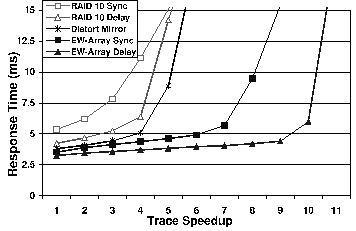


Next: Effect of the Delayed
Up: Experimental Results
Previous: Playing the Trace at
Effect of Double Synchronous Writes
Figure 12:
Effect on TPC-C throughput as we^M
write to two disks synchronously. The total number of disks is a^M
constant (36). Labels that include the word ``Delay'' denote^M
experiments that propagate all but the first replicas in the^M
background. Labels that include the word ``Sync'' denote experiments^M
that write two replicas synchronously.
 |
In the previous experiments, all but the first replicas are propagated
in the background.
To raise the degree of reliability, one may desire
to have two copies physically on disk before a
write request is allowed to return.
We now study the effect of
increasing foreground writes on three alternative configurations: a
RAID-10, a Doubly Distorted Mirror (DDM), and a
 EW-Array. The DDM performs two synchronous eager-writes and moves one
of the two copies to a fixed location in the background. We note that
the system that we have called the DDM is in fact a highly optimized
implementation that is based on the MimdRAID disk location prediction
mechanism and the eager-writing scheduling algorithms, features not
detailed in the words of ``write anywhere'' in the simple original
simulation-based study [19]. (We do not consider SR-Arrays
because the pure form of an SR-Array involves only intra-disk
replication which does not increase the reliability of the system.)
As expected, extra foreground write slows down
both the RAID-10 and the EW-Array.
However, for a given request arrival rate that does
not cause performance collapse, the response time degradation
experienced by the RAID-10 is more pronounced than that seen on the
EW-Array. This is because the cost of an extra update-in-place
foreground write is relatively greater than that of an extra
foreground eager-write. The performance of the DDM lies in between
, because the two foreground writes enjoy some performance benefit of
eager-writing but the extra update-in-place write becomes costly,
especially when the request arrival rate is high. One of the purposes
of this third update-in-place write is to restore data locality that
might have been destroyed by the eager-writes. This is useful for
workloads that exhibit both greater burstiness and locality.
Unfortunately, the TPC-C workload is such that it does not benefit
from this data reorganization.
EW-Array. The DDM performs two synchronous eager-writes and moves one
of the two copies to a fixed location in the background. We note that
the system that we have called the DDM is in fact a highly optimized
implementation that is based on the MimdRAID disk location prediction
mechanism and the eager-writing scheduling algorithms, features not
detailed in the words of ``write anywhere'' in the simple original
simulation-based study [19]. (We do not consider SR-Arrays
because the pure form of an SR-Array involves only intra-disk
replication which does not increase the reliability of the system.)
As expected, extra foreground write slows down
both the RAID-10 and the EW-Array.
However, for a given request arrival rate that does
not cause performance collapse, the response time degradation
experienced by the RAID-10 is more pronounced than that seen on the
EW-Array. This is because the cost of an extra update-in-place
foreground write is relatively greater than that of an extra
foreground eager-write. The performance of the DDM lies in between
, because the two foreground writes enjoy some performance benefit of
eager-writing but the extra update-in-place write becomes costly,
especially when the request arrival rate is high. One of the purposes
of this third update-in-place write is to restore data locality that
might have been destroyed by the eager-writes. This is useful for
workloads that exhibit both greater burstiness and locality.
Unfortunately, the TPC-C workload is such that it does not benefit
from this data reorganization.



Next: Effect of the Delayed
Up: Experimental Results
Previous: Playing the Trace at
Chi Zhang
2001-11-16

